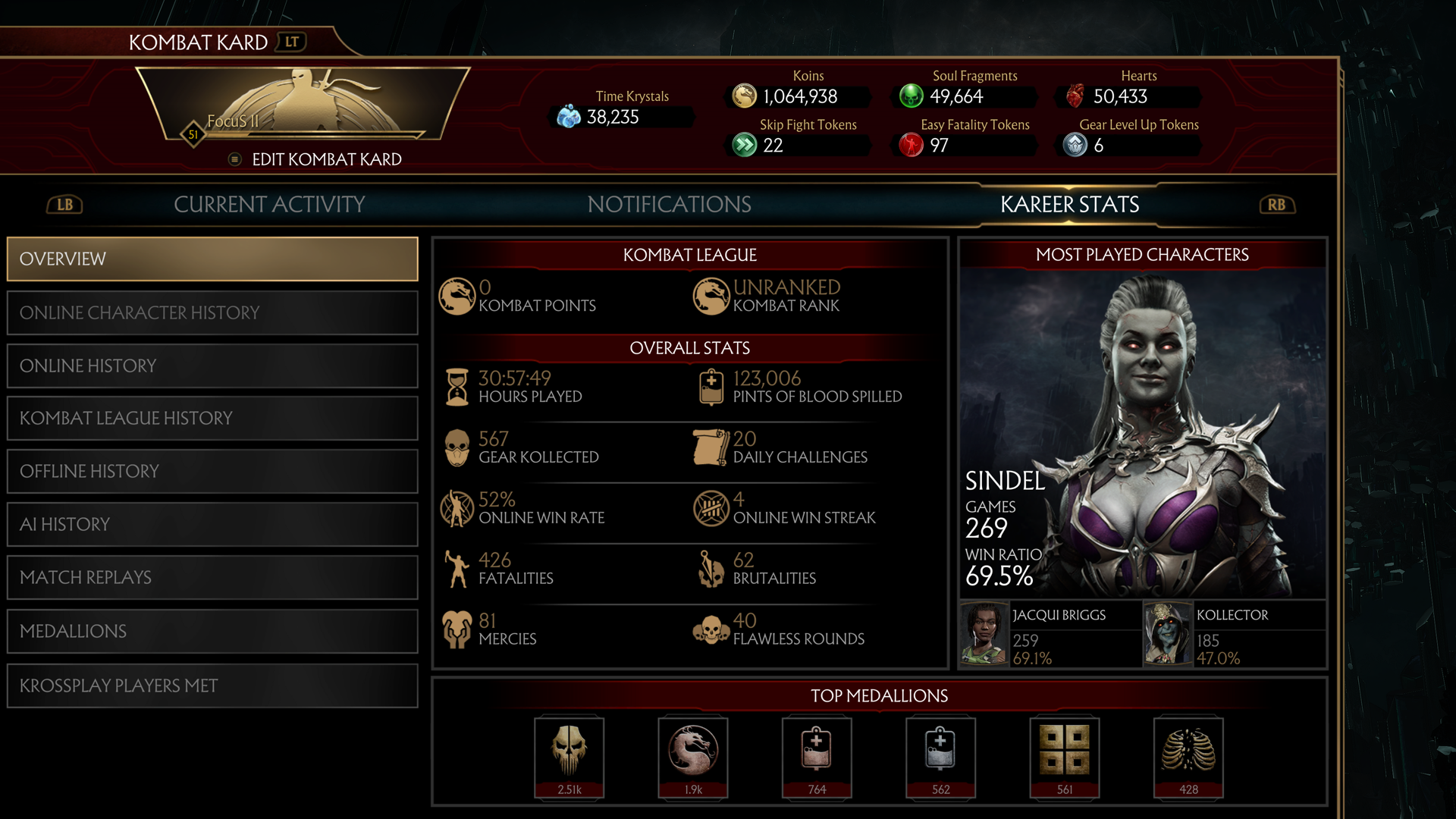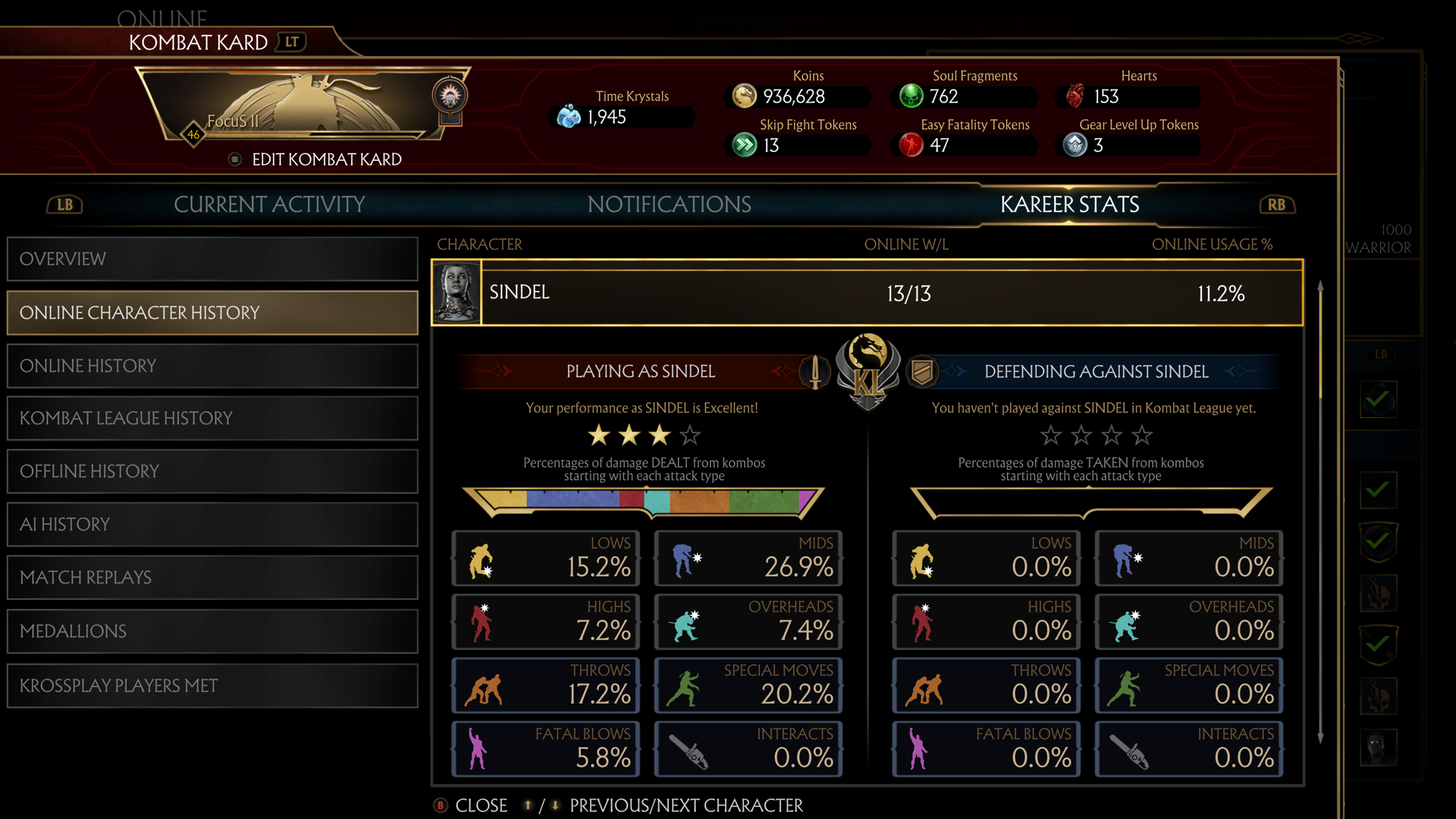Player Stories In Mortal Kombat 11
The Kombat Breakdown and the Kombat Kard “2.0” are the result of a pitch I made to tell better player stories. Starting from individual moments in matches and working up to crafting a career-wide story based on all of the player’s matches.
Let’s walk through the design objectives and how we accomplished each one.
Get the Kombat Kard out of a “spreadsheet”
After being introduced as the “Hero Card” in Injustice: Gods Among Us, the Kombat Kard made its first appearance in Mortal Kombat X. Players can choose a background image and foreground image to represent themselves in online matches and leaderboards, while also accumulating a bunch of different stats across the game. It’s basically the player’s online profile that both yourself and others can see.
Mortal Kombat X Kombat Kard
After working on my first game, Injustice 2, at NetherRealm I loved seeing all my weird stats—even if they were mostly meaningless. It’s just like how in Grand Theft Auto you get that massive list of statistics where you get to see things like your number of cars stolen, times drunk, and hotdogs eaten. People just enjoy looking at numbers of things they’ve done, but looking at them in a list just isn’t as compelling as seeing them with icons or data visualizations.
So we already had the cool stats, we just had to design a screen around it and flex the player’s identity with big images of the characters they play. But we also made sure we could reuse this screen for many different pages of stats so we weren’t designing a new screen for each page.
Mortal Kombat 11 Kombat Kard Overview page
Tell Better Match Stories
I’ve played a ton of Halo over the years—it’s one of my favorite franchises ever. Halo has this feature called the “Postgame Carnage Report” where you can see stats from the match you just played with iconography for important events: multi-kills, killing sprees, beatdowns, etc.. Actually for Halo 2 and Halo 3 you could even go on Bungie.net and see every match’s heat maps, kill-death interactions with weapon breakdowns, and more. It was awesome and you could really tell the story of the match from it. It’s where I got my main inspiration from.
Halo 5 Postgame Carnage Report
So for Mortal Kombat 11 we first needed to decide what events would help decide a match. We already had these message toasts that would pop from the side of the screen for most of these—including the combo counter. So we added symbols that worked as bullets to these messages and the combo counter. We would then reuse these symbols both after the match in the Kombat Breakdown to show what happened and also in your Kombat Kard to give a macro look at your career.
Here’s a video example. Notice the Punish message pop up, with its icon, as soon as Sindel attacks when she’s done blocking. You can also watch the combo counter escalate in this video where the MK dragon changes in color. We then created three tiers of combo damage events at 200, 300, and 400 for bronze, silver, and gold respectively.
We eventually labeled these events as Medallions. We assign a priority weight to each type of Medallion, multiply by the quantity obtained in the match, and then sort from highest to lowest. You can see here that in this match they performed 6 Punishes on their opponent (the first skull-like icon) , did 3 Air Escapes (the parachuting icon), and so on.
But this was just one way to create a narrative for the fight you just played. It doesn’t say how close the match was or how these events happened.
In shooters, players have the kill-death ratio to measure their performance. Players know that if you’re above a 1.0 then you’re doing well because you’re killing more than you’re dying. But fighting games don’t have a uniform statistic like that. And while we didn’t find a silver bullet, we did include the damage-dealt-to-taken ratio. At launch of Mortal Kombat 11, all characters had the same health pool of 1,000 points. This would later change in a patch where some characters were given 950, but at the time it was the same across the board. This meant that we could measure a player’s performance by comparing how much damage they were dealing with how much damage they were taking. We put this in the Kombat Breakdown as a raw number to start, but then quickly realized players were struggling to understand it. So we hid the number and instead translated it to a number of stars and labeled it as “Match Performance.”
The number may be more informative than the stars system, but it wasn’t immediately serving its purpose as a general performance indicator.
The stars go from 1-4 and then there’s a 5th stage where they can be on fire. So if the match was super close, meaning both players dealt and took similar amounts of damage, they would both get 3 stars because they both played well. But if one player slaughtered the other, they would 4 stars that are on fire and the other player would get just 1 star.
Here the stars are easy to understand at a glance and the description gives an indication of how we arrived at this measurement.
The final section on the Kombat Breakdown is the damage categories. This helps tell the last remaining pieces of the narrative: how and where was damage dealt.
This is helpful because you can infer a player’s playstyle: are they zoning, mixing, throwing, etc. Because you can see both player’s damage breakdowns, you can see both what is and isn’t working well for each player. Player 1 might be doing a good job mixing their opponent so they might want to keep doing that. Player 2 might see that they’re being mixed heavily and see that they need to block more overheads or lows. Or maybe they’re being thrown a lot and they need to anticipate that more. Or maybe their opponent is zoning them and all their damage is in the Special Moves category—you get the idea.
Here you can see that Kollector did 23.5% of their damage starting with Low Attacks. So if Shao Kahn were to adjust for the next match, he may want to block Low more!
One technical thing here: those health-bar-shaped pie charts are separate colored textures where all each individual one is drawn at its percentage shown through ActionScript in the Flash screen. We had to pass all that data over to the screen so the ActionScript could know at what size and position to draw each section of the texture to create the whole health bar. This took a lot longer than you might think to get right.
The Kombat Breakdown screen in full. A player can access this at the end of each Kombat League match or their most-recent Kombat Breakdown from the Online menu.
The Kombat Breakdown was eventually scoped down so it was opt-in only at the end of Kombat League matches (our ranked PvP mode) because of time constraints and a few other hurdles.
Tying Together the Micro and Macro
So we have the in-game event messaging which helps create individual match stories through the Kombat Breakdown and we also have the Kombat Kard, which is the player’s public profile.
The Kombat Kard in Mortal Kombat 11, became the one-stop shop for everything related to the player. For the first time, match replays could be downloaded by anyone and replayed so we gave them their own page in the Kombat Kard. We also had Kombat League, which ran in seasons and gave out ranks, so we also added a page where you could see a player’s Kombat League season history and all their previous ranks.
Each mode also had its own page of statistics which highlighted large character portraits for their most-played character in that mode. This helped show some personality as a lot of players have their own favorite characters and don’t usually play more than few exclusively.
And there’s also a unique page where the in-game events across all of your games stack up with titles and descriptions for each one.
But where things really start to get deep is where we accumulate the Kombat Breakdown statistics. This is where I feel like we were really successful in showing a player’s career because it can show how they play they game. Sure, you can look around the Kombat Kard and see that this person mostly plays online PvP with some Towers of Time mixed in, but this section shows how this player competes on a character-to-character basis.
Every time you complete a Kombat League match, we upload the data to your profile for both how you played as your character and how you defended against your opponent’s character. So you can go into Character History and click on a character to see both how you play as and against that character. It’s not perfect, because in an ideal world this would be some crazy matrix to see how you play as an individual character against every other character in the game, but this is a step in the right direction.
Kombat Kard > Character History > Sindel
In this particular season of Kombat League you can see I had an average of a 4-star performance, which is again calculated based on my damage-dealt vs damage-taken ratio when playing as Sindel. The Attack Breakdown here is also an average of all my matches as Sindel so this starts to craft a narrative for how I play Sindel. Someone else’s chart may look way different! This would be where I would see how I play against Sindel as well, but in this particular season I haven’t played against any Sindels. But that might give me some insight into what characters I play well or poorly against.
One of the hurdles we ran into was that a character’s meta might change after a balance patch, so the way you play as them or against them might be vastly different and it might not be represented in the data. But like I mentioned before, the Kombat Breakdown is only available after Kombat League matches, so we tied this data to the player’s active Kombat League season data. So after each season, you’re working with a fresh slate. The issue kind of solved itself in that regard—which is always great!
TL;DR
We leveraged in-game events and data to encapsulate the match story in a single screen with the Kombat Breakdown. The Kombat Breakdown then gets dissolved into the Kombat Kard to help create a career-wide story in combination with a bunch of other mode stats, ranked season histories, match replays, and more. The Kombat Kard now represents the player through their customized background/foreground, their most-played characters, and also the data which shows how they interact with Mortal Kombat 11.










